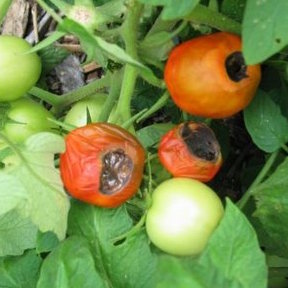A trending situation this summer (2017) is an increase in reports of blossom end rot, that classic problem where by otherwise fine looking fruit get a nasty blemish at the base. Although you may still - at least technically - eat the unaffected portion of the fruit, it certainly is a discouraging outcome after all of your hard work, and realistically most blemished tomatoes get composted rather than eaten. The frustrating thing about 2017 is that blossom end rot is happening even in situations where gardeners are doing the right things: using a tomato-specific fertilizer and even watering regularly; so what is going on?

The higher incidence of blossom end rot almost certainly has to do with it being a very dry summer. The problem is not caused by a pathogen, but rather a physiological issue relating to how calcium is transferred from soil to plant to fruit (calcium being essential for healthy fruit development). The successful uptake of calcium is closely tied to soil moisture, and the blossom end of the developing fruit is the area furtherest along the path that water and nutrients travel inside the plant's vascular system. The problem is always compounded when tomatoes are growing in pots, as these are much harder to keep evenly moist compared to in ground.
More than ever, a dry summer requires good deep watering at the base of tomato plants (peppers, eggplant, squash, pumpkins and cucumbers as well), preferable applied early in the day. To increase the benefits of watering, and avoid rapid drying, mulching is a very good idea (lose leaves, shredded paper, coco-coir disks), as is the removal of extraneous lower leaves on big, leafy tomato plants. To avoid blossom end rot, tomatoes should never be allowed to wilt, and the outer roots of container plants never allowed to dry out. Also, avoid mineral salt fertilizers (think miracle) as these salts compete with available calcium for transfer to the fruits; and do not apply fertilizers of any type when the soil is dry. If you have been using a compost based tomato fertilizer and are growing your plants in quality soil... but are still getting blossom end rot... it means the plants need deeper, even more regular watering.
We often hear about adding egg shells as a natural source of supplemental calcium; good idea early in the season if the egg shells are finely pulverized, but unfortunately not likely to offer any benefit later in summer to correct plants exhibiting blossom end rot. A more soluble calcium source such as Evolve Calcium Essentials may be helpful, in conjunction with deeper watering.
An common gardener's myth is that Epsom Salts (magnesium sulphate) help with blossom end rot... they do not, and may actually make the problem worse by creating competition between the magnesium and calcium ions.
Gardeners do notice that some varieties are more resistant to blossom end rot than others, so it is worth making some notes in your gardening journal, which can inform your planting decisions for next season.
The good new is that plants experiencing blossom end rot are not in any way diseased, and fruits not currently affected can develop to maturity if the moisture issue is corrected. All the best!







